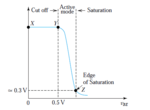muheeb16
Member level 3
So it is operated in either saturation or cut off region but in between these two there is linear region (the intermediate region between the LOW and HIGH states of the transistor) and the transistor will obviously pass through that going from cut off to saturation and vice versa.How does that work?

